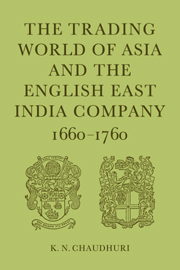Book contents
- Frontmatter
- Contents
- Tables
- Figures
- Maps
- Abbreviations
- Notes on dates, contemporaneous spellings, currency, and weights
- Preface
- Acknowledgements
- 1 The international economy and the East India trade
- 2 A formal theoretical model of the East India Company's trade
- 3 The structure of early trade and the pattern of commercial settlements in Asia
- 4 The evolution of the Company's trading system: operation and policy 1660–1760
- 5 Long-term trends and fluctuations 1660–1760
- 6 Politics of trade
- 7 Markets, merchants, and the Company
- 8 The export of treasure and the monetary system
- 9 The structure of country trade in Asia
- 10 Export of European commodities
- 11 The Company and the Indian textile industry
- 12 The Company's trade in textiles
- 13 Pepper
- 14 Import of bulk goods
- 15 Raw silk
- 16 Coffee
- 17 Imports from China
- 18 Financial results
- 19 Conclusion
- APPENDICES
- General glossary
- Bibliography
- Short titles cited in the reference notes
- Notes
- Index
4 - The evolution of the Company's trading system: operation and policy 1660–1760
Published online by Cambridge University Press: 06 July 2010
- Frontmatter
- Contents
- Tables
- Figures
- Maps
- Abbreviations
- Notes on dates, contemporaneous spellings, currency, and weights
- Preface
- Acknowledgements
- 1 The international economy and the East India trade
- 2 A formal theoretical model of the East India Company's trade
- 3 The structure of early trade and the pattern of commercial settlements in Asia
- 4 The evolution of the Company's trading system: operation and policy 1660–1760
- 5 Long-term trends and fluctuations 1660–1760
- 6 Politics of trade
- 7 Markets, merchants, and the Company
- 8 The export of treasure and the monetary system
- 9 The structure of country trade in Asia
- 10 Export of European commodities
- 11 The Company and the Indian textile industry
- 12 The Company's trade in textiles
- 13 Pepper
- 14 Import of bulk goods
- 15 Raw silk
- 16 Coffee
- 17 Imports from China
- 18 Financial results
- 19 Conclusion
- APPENDICES
- General glossary
- Bibliography
- Short titles cited in the reference notes
- Notes
- Index
Summary
Decision-making on the level of trade
It is evident from an analysis of the Company's general policy on its commercial organisation in Asia that this was an area where the discrepancy between the decisions and planning undertaken by the central controllers in London and the actual implementation at the operational end in the East Indies was at its minimum. The Court of Directors was seldom prepared to tolerate for too long flagrant disregard of its orders on the maintenance of unwanted factories and settlements that showed a persistent incapacity to make profits. But this aspect of the Company's decision-making only required action at infrequent intervals. The temporal pattern of the Company's trading organisation in the Indies can be compared to those components which incorporate the trend and regular cycles. When the Committee of Correspondence sat down to consider the merits and demerits of a particular trading region or a settlement, its location, political security, accessibility to markets, transport costs, and so on, they were not thinking in other than static terms. Where the time factor actively entered into their considerations, it was as changes by a series of approximations towards the ideal objectives, the criteria that determined the position and value of a settlement. When conditions at a particular settlement reached near enough to the objectives, a partial equilibrium was achieved. From a theoretical point it was not difficult to lay down precise directives on such matters and the Company's servants had no particular interest in going against the policy of Leadenhall Street.
- Type
- Chapter
- Information
- The Trading World of Asia and the English East India Company1660-1760, pp. 57 - 78Publisher: Cambridge University PressPrint publication year: 1978



